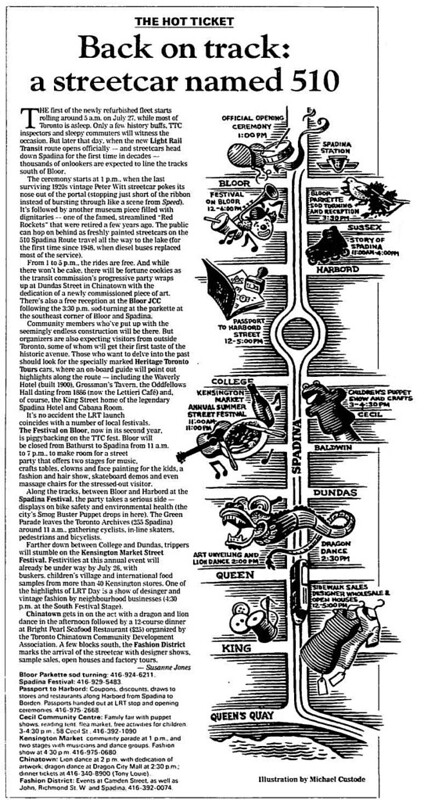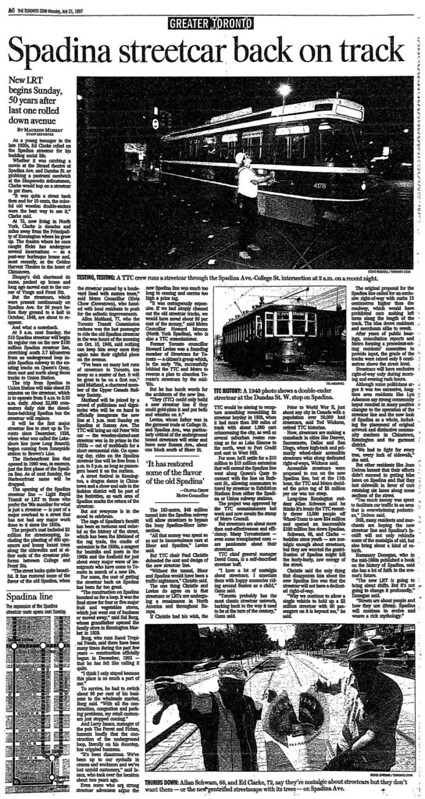off the grid: retro t.o. waitin' for the spadina streetcar
This installment of my "Retro T.O." column for The Grid was originally published on June 19, 2012.
Lovers of wild pants and saxophones rejoice! As of this week, the Spadina bus of 1980s musical fame has returned while platform reconstruction takes the streetcar right-of-way out of service for several months. And the return of bus service might reawaken arguments that stalled the construction of the Spadina streetcar line for years.
It’s possible opponents of the line forgot that Spadina had a long history of streetcar service, complete with a right-of-way down its spine, that operated from 1892 to 1948. Its demise came when streetcar service was “temporarily” suspended to conserve power amid postwar electrical shortages, though some city councillors were inclined to scrap it during proposals to widen Spadina Avenue. Apart from a stretch of track utilized by the Harbord streetcar until 1966, regular and trolley buses became the means of transit for the next half-century.
When the TTC scrapped its plan to eliminate all streetcar service in the early 1970s, it was amenable to a proposal from transit activists Streetcars for Toronto to restore cars to Spadina. Noise concerns from residents and the provincial government’s preference for investing in new forms of transit equipment (think Scarborough RT) resulted in the idea being shelved. A decade later, a revised TTC proposal, in partnership with a Harbourfront line, was backed by the Star. A May 1983 editorial declared that a streetcar separated from traffic would be speedier than the “buses which now have to pick their way through Spadina’s horrendous congestion.”
A decade-long war over what became known as the Spadina LRT ensued. On the pro-side were the TTC and various levels of government seeking downtown transit improvements. Metro Toronto chairman Dennis Flynn saw potential for easing the strain on the Yonge-University line by providing an alternative for west-end commuters heading into the core. The separated right-of-way would lessen traffic jams that occasionally made walking a speedier form of transit. The anti-side echoed many complaints heard about major streetcar and LRT projects that followed: destruction of businesses, construction nightmares, narrowed sidewalks, and loss of parking (angled at the time on Spadina). A major fear was that heavy trucks unable to cross a 15 cm–high concrete barrier would disrupt residential neighbourhoods to make their deliveries. As for the route’s vibrant street life, Star columnist David Lewis Stein felt that the right-of-way would “put an end to the boisterous anarchy that exists on Spadina.” He also noted that “this looks like one of those classic fights between planners obsessed with speed and efficiency and people … who cherish the history and human values of Spadina.”
An endless series of public consultations and holdups followed that produced a series of compromises before the line was finally green-lit in 1992. Major concessions included reducing sidewalk loss, installing trees, lowering the barrier/raising the tracks so that vehicles could turn left anywhere along the street, and only enforcing the right-of-way during rush hours.
Among the dignitaries who rode a vintage Peter Witt streetcar for the line’s official launch on July 27, 1997 was 77-year-old railway enthusiast Allen Maitland, who the TTC figured was among the last riders of the original Spadina car. “I’ve been on many last runs of streetcars in Toronto,” Maitland told the Star, “too many in fact. It will be great to be on a first run.” Accompanying first-day activities included 32,000 free afternoon rides and a series of festivals and sidewalk sales that featured dancing dragons and puppet shows. Ronald Vanstone rode the line four times that day to film the route—“It’s a great sightseeing trip. You can taste different cultural flavours all at once.” Some who feared its effects changed their tune, including David Lewis Stein, who declared that he had “fallen in love” with the line. As for the vacant storefronts on the strip, the blame was placed more on the recession of the early 1990s and the local Chinese community’s move northward than the streetcar.
One compromise opponents insisted on proved disastrous. During the line’s first year there were 160 collisions between streetcars and other vehicles. Most of the accidents happened when cars tried to turn left at non-signalled intersections. Globe and Mail columnist John Barber awarded the “biggest bonehead award” to a driver who turned into the side of a streetcar that had just stopped beside him. The driver told the streetcar operator, “I didn’t see you.”
The long-contested barriers were installed.
Additional material from the October 4, 1985 and September 4, 1997 editions of the Globe and Mail, and the May 13, 1983, June 4, 1986, July 21, 1997, July 28, 1997, August 10, 1997, and July 14, 1998 editions of the Toronto Star.
 |
| Globe and Mail, July 26, 1997. Click on image for larger version. |
It’s possible opponents of the line forgot that Spadina had a long history of streetcar service, complete with a right-of-way down its spine, that operated from 1892 to 1948. Its demise came when streetcar service was “temporarily” suspended to conserve power amid postwar electrical shortages, though some city councillors were inclined to scrap it during proposals to widen Spadina Avenue. Apart from a stretch of track utilized by the Harbord streetcar until 1966, regular and trolley buses became the means of transit for the next half-century.
When the TTC scrapped its plan to eliminate all streetcar service in the early 1970s, it was amenable to a proposal from transit activists Streetcars for Toronto to restore cars to Spadina. Noise concerns from residents and the provincial government’s preference for investing in new forms of transit equipment (think Scarborough RT) resulted in the idea being shelved. A decade later, a revised TTC proposal, in partnership with a Harbourfront line, was backed by the Star. A May 1983 editorial declared that a streetcar separated from traffic would be speedier than the “buses which now have to pick their way through Spadina’s horrendous congestion.”
 |
| Toronto Star, March 29, 1992. |
An endless series of public consultations and holdups followed that produced a series of compromises before the line was finally green-lit in 1992. Major concessions included reducing sidewalk loss, installing trees, lowering the barrier/raising the tracks so that vehicles could turn left anywhere along the street, and only enforcing the right-of-way during rush hours.
 |
| Toronto Star, July 21, 1997. Click on image for larger version. |
One compromise opponents insisted on proved disastrous. During the line’s first year there were 160 collisions between streetcars and other vehicles. Most of the accidents happened when cars tried to turn left at non-signalled intersections. Globe and Mail columnist John Barber awarded the “biggest bonehead award” to a driver who turned into the side of a streetcar that had just stopped beside him. The driver told the streetcar operator, “I didn’t see you.”
The long-contested barriers were installed.
Additional material from the October 4, 1985 and September 4, 1997 editions of the Globe and Mail, and the May 13, 1983, June 4, 1986, July 21, 1997, July 28, 1997, August 10, 1997, and July 14, 1998 editions of the Toronto Star.

Comments